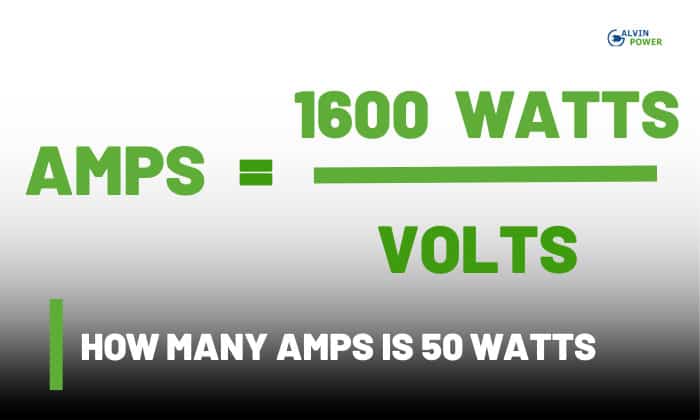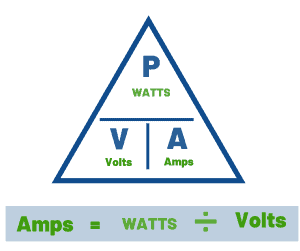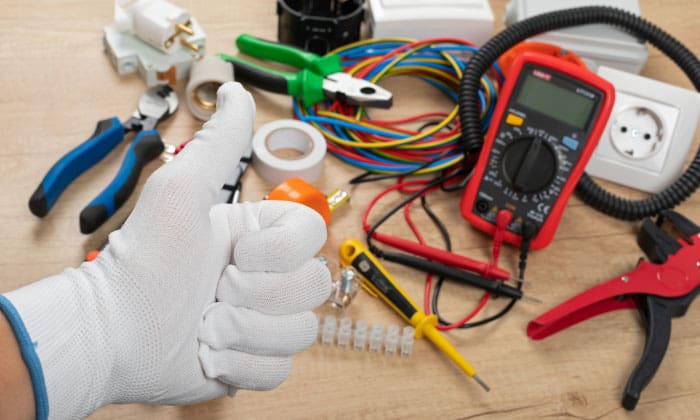Understanding Watts, volts, and Amps, as well as the relationship between them, helps determine the electrical requirements of appliances. This prevents the chances of overloading circuits, ensures safety, and allows homeowners to make informed decisions regarding electrical installations and equipment usage.
In this article, we’ll look at ” how many amps is 1600 watts “. Learn how to convert Watts to Amps using simple calculations and how it could be useful in actual situations.
Table of Contents
Converting 1600 Watts to Amps
1. How to Convert Watts to Amps
When converting watts to amps, one important factor to consider is the system voltage and electrical phases of the current where you need to use your 1600 watts device. This could be in different voltage ratings at a Direct Current, a Single phase, or a three-phase electrical connection.
To give you an idea of how much 1600 watts into amps are at different system voltages, look at the table I provide below and see how they differ at various system voltage and electrical phases.
| Phases | System Voltage | 1600 Watts = Amps (in Different Voltage Ratings) |
| Direct Current | 12v | 133.33 Amps |
| 24v | 66.67 Amps | |
| AC Single Phase (PF = .5) | 120v | 26.67 Amps |
| 240v | 13.33 Amps | |
| AC Three Phase (Line to Line Voltage) (PF = .5) |
480v | 3.85 Amps |
| 600v | 3.08 Amps | |
| AC Three Phase (Line to Neutral Voltage) (PF = .5) |
277v | 3.85 Amps |
| 347v | 3.07 Amps |
2. How to Calculate
To calculate watts to current, you have a few two options. An online conversion can provide a quick and easy solution, while manual calculations involve specific formulas for different electrical connections. Let’s explore both methods.
1. Online Watts to Amps Conversion
When converting watt to amp, an online calculator is one convenient way. You just need to input the watts rating, select the device’s phases, voltage rating, and power factor, and the result will be posted immediately.
2. Manual Calculation using Different Formula for Watts to Amps
If you wonder how to calculate amps from watts using manual Calculation, here’s a proper formula for each phase and how it works.
- For DC Connections
The formula to convert watts to amps in a direct current (DC) system is Amps = Watts / Volts. For example, if you have a device with a power rating of 1600 watts and a voltage of 24 volts, the Calculation would be:
\[ \text{Amps} = \frac{1600 \, \text{watts}}{24 \, \text{volts}} \]
\[ \text{Amps} \approx 66.67 \, \text{amps} \]
- For AC Single-Phase
When dealing with single-phase alternating current (AC), the formula becomes Amps = Watts / (Power Factor × Volts). For instance, if you have a 1600-watt device with a power factor of 0.5 and a voltage of 220v, the Calculation would be:
\[ \text{Amps} = \frac{1600 \, \text{watts}}{0.5 \, \text{power factor} \times 220 \, \text{volts}} \]
\[ \text{Amps} \approx 14.54 \, \text{amps} \]
- For AC Three-Phase Line-to-Line Voltage
If you are working with three-phase line-to-line voltage, the formula is Amps = Watts / (√3 × Power Factor × Volts). For example, with a 1600-watt device, a power factor of 0.5, and a voltage of 480 volts, the Calculation would be:
\[ \text{Amps} = \frac{1600 \, \text{watts}}{\sqrt{3} \times 0.5 \, \text{power factor} \times 480 \, \text{volts}} \]
\[ \text{Amps} \approx 3.85 \, \text{amps} \]
- For AC Three-Phase Line-to-Neutral Voltage
Finally, when dealing with three-phase line-to-neutral voltage, the formula is Amps = Watts / (3 × Power Factor × Volts). For instance, with a 1600-watt device, a power factor of 0.5, and a voltage of 480 volts, the calculation would be:
\[ \text{Amps} = \frac{1600 \, \text{watts}}{3 \times 0.5 \, \text{power factor} \times 277 \, \text{volts}} \]
\[ \text{Amps} \approx 3.85 \, \text{amps} \]
-
- Note: Remember to use the appropriate formula based on your specific electrical system to find amps from watts accurately.
Factors that Affect Amps and Watts
1. Voltage
Voltage has a direct impact on amps and watts. Increasing the voltage while keeping the current constant results in a larger watt output. On the other hand, decreasing voltage needs a larger current to maintain the same power level.
2. Resistance
The resistance in an electrical circuit also affects its amperage and wattage. According to Ohm’s law, V = I × R. Therefore, if the resistance increases while the voltage remains constant, the current will decrease, leading to lower amperage. Similarly, an increase in resistance will result in a decrease in wattage.
3. Power Factor
Power factor measures how efficiently electrical power is converted into productive work. At the same wattage, devices with low power factors demand more current than those with high power factors.
4. Electrical Phases
The number of electrical phases influences amps and watts, especially in three-phase systems. Three-phase circuits use less current than single-phase or direct current systems with the same voltage and wattage.
Electrical Safety and Current Limitations
Different appliances have different amp requirements that must be considered to prevent electrical problems. Each current can only deliver a certain amount of power, referred to as the maximum allowable current. Should an electrical circuit or device draw more current than safety thresholds, it could cause damage or trigger protection.
Here are some common household appliances and their amperage ratings.
| Appliances | Estimated Watts Used | Estimated Amps Used |
| Standard Fridge | 150 watts | 1.5 amps |
| Electric Kettle | 3000 watts | 13 amps |
| Radio | 15 watts | 0.5 amps |
| TV (55 UHD) | 120 watts | 0.5 amps |
| Microwave | 1500 watts | 6.5 amps |
| Hair Dryer | 2200 watts | 10 amps |
| Washing Machine | 2200 watts | 10 amps |
| Portable AC | 2000 watts | 9.3 amps |
Remember that these are general estimates, and the amp requirements may vary depending on the specific model and manufacturer and the standard power supply used in each country.
Read next:
Tips for Reducing Electrical Usage and Saving Energy
Here are some helpful tips to lower the power consumption of your home:
- Use natural lighting during the day whenever possible.
- Use energy-efficient appliances and lighting.
- Unplug any devices when not in use.
- Avoid frequent opening and closing of the refrigerator.
- Optimize your home’s insulation to reduce heating and cooling needs.
Conclusion
In conclusion, knowing how many amps is 1600 watts is crucial for constructing a safe and energy-efficient current. This is also helpful in preventing accidents and damage to electrical equipment.
Remember that multiple methods can be used to determine the proper outcomes when converting 1 amp = watts. However, when it comes to a more complex electrical system, it is always advisable to consult with a professional to ensure accurate calculations and adherence to safety guidelines.

I am Edwin Jones, in charge of designing content for Galvinpower. I aspire to use my experiences in marketing to create reliable and necessary information to help our readers. It has been fun to work with Andrew and apply his incredible knowledge to our content.




